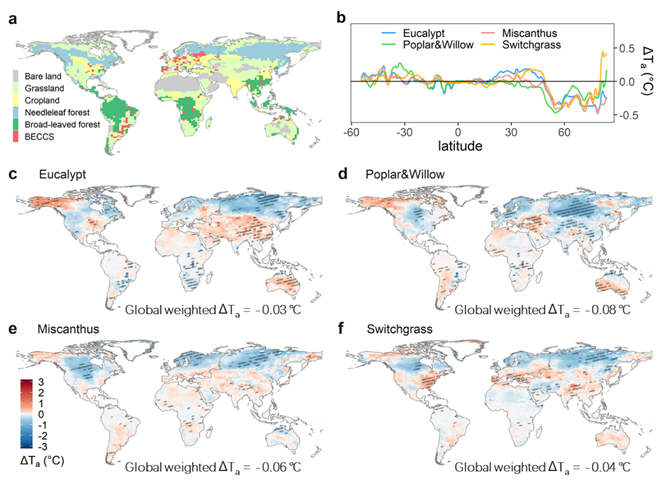Li Wei’s Research Group of the Department of Earth System Science (DESS), Tsinghua University has recently published a research paper online, revealing the biophysical effects of growing bioenergy crops at large scale in the world, and exploring the impact of different bioenergy crop types, distributions and planting areas on biophysical effects.
Bioenergy with carbon capture and storage (BECCS) is one of the main measures to slow down climate change and realize carbon neutrality. Its basic principle is to absorb atmospheric carbon dioxide (CO2) by planting fast-growing bioenergy crops, convert it into energy after harvest, and collect CO2 generated by use for storage, so as to realize negative CO2 emission throughout the whole life cycle. On the one hand, growing bioenergy crops at large scale can reduce atmospheric CO2 concentration, thus reducing radiative forcing and achieving the goal of controlling temperature rise; on the other hand, it can directly change the surface biophysical characteristics (such as albedo, evapotranspiration, surface roughness, etc.), and then affect the temperature change, that is, exerting biophysical effect. The biophysical effects of bioenergy crops are still unclear in future large-scale cultivation scenarios.
Therefore, Li Wei’s Research Group of the Department of Earth System Science, Tsinghua University, in conjunction with many research institutions at home and abroad, has conducted research on the biophysical effects of global large-scale bioenergy crop cultivation scenarios. The research team used the dynamic global vegetation model bioenergy crop version, which was coupled with the atmospheric model, to explore the impact of four bioenergy crops on air temperature through biophysical processes under different cultivation scenarios in the future (Fig. 1). The model version includes the detailed physiological ecology and management process of bioenergy crops independently developed by the research group. It has been found that growing bioenergy crops at large scale can reduce the global average land temperature by 0.03~0.08 °C through biophysical processes, but the spatial heterogeneity of biophysical effects in different regions is remarkable. The cooling effect is more obvious in woody crop cultivation regions due to stronger transpiration and smaller aerodynamic impedance. This study evaluates the biophysical effects of large-scale bioenergy crop cultivation, with important implications for the formulation of climate change mitigation policies and the rational planning of bioenergy cultivation in the future.
The above-mentioned achievements have been published in a paper entitled “Global cooling induced by biophysical effects of bioenergy crop cultivation” in the journal Nature Communications. Wang Jingmeng, a doctoral student in the Department of Earth System Science, Tsinghua University, is the first author of the paper, and Associate Professor Li Wei is its corresponding author. Co-authors include Professor Philippe Ciais, Researcher Daniel Goll and Dr. Narayanappa Devaraju of Laboratoire des Sciences du Climat et de l’Environnement (LSCE), Professor Laurent Li of Laboratoire de Météorologie Dynamique, Researcher Chang Jinfeng of the School of Environment and Resources of Zhejiang University, Researcher Thomas Gasser of the International Institute for Applied Systems Analysis (IIASA), Associate Professor Huang Xiaomeng of the Department of Earth System Science, Tsinghua University, and Researcher Olivier Boucher of Sorbonne Université/IPSL. The research has been supported by the National Natural Science Foundation of China, the National Key Research and Development Program, the Independent Research Program of Tsinghua University and “Earth System Numerical Simulation Facility”, a national key science and technology infrastructure project.
Paper link:
https://www.nature.com/articles/s41467-021-27520-0
Li Wei’s research group of the Department of Earth Science System, Tsinghua University has by far carried out a number of studies on the ecological effects of bioenergy crops. The research group has compiled an observation database of yield per unit area of major bioenergy crops in the world, and used the machine learning method to generate a global grid scale map of yield per unit area of energy crops. According to different future planting scenarios, the global output and nutrient demand of bioenergy crops have been estimated. In addition, the research group has independently developed a bioenergy crop module in the dynamic vegetation model, and simulated the ecological effects of future bioenergy crop cultivation by using the bioenergy crop version developed.
Related papers:
[1] Wang J, Li W, Ciais P, Li L, Chang J, Goll D, Gasser T, Huang X, Devaraju N, Boucher O. 2021. Global cooling induced by biophysical effects of bioenergy crop cultivation [J]. Nature Communications, doi: 10.1038/s41467-021-27520-0
[2] Li W, Yue C, Ciais P, Chang J, Goll D, Zhu D, Peng S, Jornet-Puig A. 2018. ORCHIDEE-MICT-BIOENERGY: an attempt to represent the production of lignocellulosic crops for bioenergy in a global vegetation model [J]. Geoscientific Model Development, 11(6): 2249-2272.
[3] Li W, Ciais P, Makowski D, Peng S. 2018. A global yield dataset for major lignocellulosic bioenergy crops based on field measurements [J]. Scientific Data, 5: 180169.
[4] Li W, Ciais P, Stehfest E, van Vuuren D, Popp A, Arneth A, Di Fulvio F, Doelman J, Humpenöder F, Harper A B, Park T, Makowski D, Havlik P, Obersteiner M, Wang J, Krause A, Liu W. 2020. Mapping the yields of lignocellulosic bioenergy crops from observations at the global scale [J]. Earth System Science Data, 12(2): 789-804.
[5] Li W, Ciais P, Han M, Zhao Q, Chang J, Goll D S, Zhu L, Wang J. 2021. Bioenergy Crops for Low Warming Targets Require Half of the Present Agricultural Fertilizer Use [J]. Environmental Science & Technology, 55(15): 10654-10661.

Fig. 1 Temperature changes caused by cultivation of four kinds of bioenergy crops (the distribution of growing areas is shown in red in Figure a, the temperature changes caused by biophysical effects of four kinds of bioenergy crops are shown in Figures c-f, and the corresponding latitudinal average is shown in Figure b)
Written:Wang Jingmeng